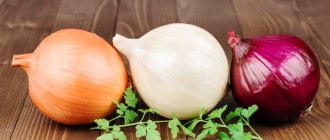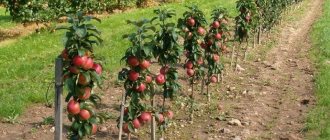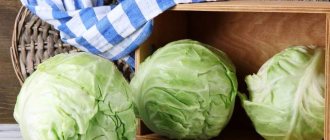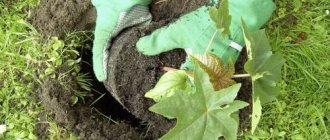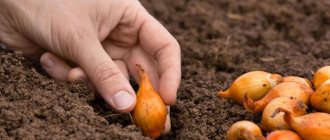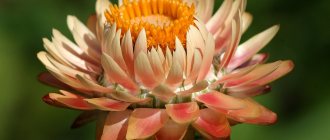It is difficult to find a person who would not know what an onion is. Some gardeners grow onions for seedlings; today we will talk about when to plant the crop in 2021.
Dear readers! For you, we have created communities on social networks in which useful articles and interesting ideas are published several times a day! Subscribe and receive useful content in a convenient format!
Typically, growing onions involves a three-year cycle:
- 1st year. Nigella is sown for seeding.
- 2nd year. Seeds are planted to obtain a large onion.
- 3rd year. A large onion is planted and it produces seeds.
The stage of growing and preserving the seeds can be skipped. That is, get large bulbs within one year. And this is achieved by growing onions through seedlings. With this method of agricultural technology, the onion shoots less, and the bulb itself grows larger.
Favorable days for planting seeds for seedlings in 2021
You need to sow seeds for seedlings starting in February, depending on the region. The further south you go, the earlier you plant. Many gardeners sow seeds of various plants according to the lunar calendar. And it has been proven many times that it works.
Favorable days for sowing onions for seedlings in 2021 to get a bulb
| Month | Number |
| February | 2-9; 28 |
| March | 1-12 and 29-31 |
| April | 2-10 and 28, 29, 30 |
Note! It is worth noting that the number indicated in the table does not mean the day the seed is planted in a seedling box or greenhouse, but the day when they begin to work with this seed, that is, they disinfect it, soak it, etc.
Favorable days according to the lunar calendar in 2021 for sowing onions
| Month | Number |
| February | 13 – 25 |
| March | 15 – 26 |
| April | 14-25 |
When is it not worth sowing onions for seedlings in 2021?
There are both favorable days in the year when you need to plant onion seeds for seedlings, and unfavorable ones. The table below shows the days on which it is not advisable to engage in agricultural practices.
| Month | Number |
| February | 10, 11, 27 |
| March | 9, 10, 11, 13, 28 |
| April | 6, 7, 12, 27 |
Knowing the favorable and not so favorable days for sowing onions, and sticking to them, you can grow a good harvest.
Note! If it is not possible to plant seeds at the right time, it is better to plant on days that are not indicated as unfavorable. This promotes better seed germination.
The benefits of planting onions in the fall
You can get a good harvest of onions if you plant them in the autumn. This is due to many advantages:
- Onions planted in October or November germinate 20 days earlier than spring onions, and can be harvested 2 months earlier. This means that the beds will not be empty - the gardener will have time to grow on them, at least, lettuce for his table.
- Winter species are initially cold-resistant, tolerate low temperatures well, and grow on different soils. On spring days, they are fully provided with moisture - the result of melting snow, which cannot be said about spring onions, which may not have enough water.
- The winter onion itself is larger and has a high yield.
- Planting in the fall practically eliminates damage from insect pests, powdery mildew and rot, and in the spring there is no need to constantly weed the ground.
- If an onion set is planted before winter, then, as a rule, it does not grow arrows, but large vegetables will certainly have them, and, along with this, greens, abundant and fragrant.
In addition, in the fall there is not much work in the garden, and planting onions will not cause much trouble. The only disadvantage of winter crops is its shelf life, which is worse than that of spring varieties. Of course, for the winter, the beds with onions will need to be covered, and since some plants can freeze out, due to natural selection, you have to plant a little more planting material (10-15%).
It is also sometimes difficult to determine the exact time for disembarkation based only on the weather. Because of this, late-planted onions do not have time to develop a root system and freeze over the winter. That is why many gardeners advise choosing the time based on the lunar calendar. Due to incorrect timing, the vegetable is able to germinate, and its delicate feathers freeze, and as a result, you may not have a normal harvest next year.
When to plant onions for seedlings to grow in one year?
Often, stores sell sets of not very good quality. And many gardeners began to switch to growing onions using seedlings. The process is, of course, difficult, but the result is worth the effort. They begin to sow nigella seedlings at the end of winter and until mid-spring. And in mid-May, after the threat of spring frosts, the seedlings are planted in a permanent place.
Features of cultivation
To plant onions before winter, choose a bed on the south side of the site, where there are no drafts. It is necessary to observe crop rotation - do not replant the crop in the same place for 2 years after harvest. The best predecessors for onions are cucumbers, tomatoes, and potatoes. Planting work is carried out in calm weather, in the absence of precipitation.
Preparation of planting material and soil
For planting, heads with a diameter of 1-1.5 cm are selected, damaged and rotten specimens are discarded. Before planting, the planting material is disinfected - placed for 30 minutes in a fungicide solution (Maxim, Topaz) or in a weak solution of potassium permanganate. Soaking the bulbs is not recommended - early germination of the crop is possible.
Winter onions grow well in loamy and sandy soils. The crop should not be planted on acidified soils or with close groundwater. Winter onions are planted when the ground temperature drops to 0ºC. Before work is carried out, the soil is fertilized - compost or humus is added (average consumption 5 kg per 1 m²).
Planting and care
10-15 days before planting, the ground is dug up and covered with cellophane - this activity is necessary to warm the soil. Onions are planted in furrows up to 5 cm deep, leaving row spacing of 10 cm. For the winter, the plantings are mulched with leaves and covered with spruce branches. In winter, the beds are covered with snow. With the onset of spring, the crop requires further care:
- When the return frosts recede, the mulch layer is removed.
- After each rain or watering, the soil must be loosened and weeds removed.
- In dense plantings, the seedlings are thinned out.
- To protect against pests, marigolds or nasturtium are planted around the perimeter of the beds.
Important!
It is not recommended to bury planting material to a depth of more than 5 cm - the bulbs will not germinate.
To get large onions, you need to fertilize the vegetable crop 2 times per season. When seedlings appear, the beds are watered with a solution of bird droppings prepared in a ratio of water to active substance of 1:10. In mid-May, onions are fed with nitrophoska or cow manure. If the soil is acidic, fertilizing with wood ash is required.
When to plant onions to get feathers?
Onions can be planted on the feather in both autumn and spring.
Autumn planting
To get a ready-made harvest of green onions in early spring, you need to plant medium-sized sets in the fall. A larger set will grow into a shoot, and you won’t be able to get greenery; a smaller one will be suitable for cutting only in the fall.
Spring planting
In the spring, culling sets can also be planted on greens. Only slightly thicker than onion.
Greens from seeds
Fragrant, healthy onions can also be grown from seeds - nigella. Seeds, like seedlings, can be sown in the fall or in the spring. Winter onions will give an earlier harvest of greens. Plants sown in spring will be ready for cutting in late August to mid-September.
By correctly sowing onion seeds or greens sets, you can enjoy this healthy product from early to late autumn.
Planting onions before winter - saving time in spring
Many gardeners have been familiar with the technology of growing winter onions for a long time, but even today it is not widespread. Most summer residents are still grappling with a number of questions:
- Is it even possible to plant onions for the winter?
- What varieties should you choose?
- When exactly should you plant?
Note! The spring season is a special period for summer residents, when a lot of worries arise, and therefore it is worth planting crops in the fall, which will subsequently save time.
Planting onions
Any crop (onion or garlic) planted for the winter begins to bear fruit first in the spring. Moreover, the harvest is of higher quality, in contrast to traditional spring sowing. In other words, planting in the fall takes place.
The benefits of planting onions in the fall
There are no barriers to planting onions in the fall. Winter crops have a number of advantages compared to traditional spring sowing:
- The plant bears fruit a month earlier than usual.
- Onions planted for the winter do not require special care.
- The winter crop is not going well.
- The bulbs themselves grow larger in size.
- For the winter, as a rule, small-sized sets are planted, but they are unlikely to survive until spring and would have to be thrown out anyway.
Worth knowing! It’s just important to consider that this technology also has its downsides. Firstly, winter crops withstand storage conditions worse than spring crops. Secondly, some of the plantings die during the winter period. Thirdly, failure to comply with planting deadlines (too early or late) leads to the destruction of the crop.
When to sow onions in different regions
In different regions, although not significantly, the timing of planting onions for seedlings will differ from each other. In the central regions the climate is somewhat warmer than in Siberia. And accordingly, the soil there will warm up earlier. Let's consider planting dates in some regions.
When to sow onions in 2021 in the Moscow region
In the Moscow region, seedlings are planted in late March - early April. If you consider that the seedlings should not be less than one and a half months old, it is not difficult to calculate when to sow nigella in boxes. This is the beginning or middle of February.
Time to plant onion seedlings in Siberia
In Siberia the climate is very cold. It is necessary to sow seeds for seedlings, as well as plant young shoots in a permanent place, somewhat later than in the Moscow region. But this does not mean that seeds for seedlings should be sown later. On the contrary, those who have repeatedly grown this crop are advised to plant earlier, in February and even the end of January; early March is also suitable. They are transferred to the beds towards the end of May. After planting seedlings in open ground at night, the beds must be covered with spandbond or film.
Interesting! If you believe the reviews of gardeners from Siberia, it is believed that the later you sow onions, the smaller the bulb will be.
Sowing onions in the Urals
In the Urals, gardeners also grow onions through seedlings. They write on the packs of seeding material. In order to calculate the time of sowing seeds in the soil, you need to determine when the seedlings will be 55-65 days old when planted in open ground. But again, many gardeners begin to plant onion seedlings in February, but no later than the beginning of March, and plant seedlings in mid-May, when the soil in the garden bed warms up to +15°C.
The right time in 2021 for the middle lane
The climate of the middle zone is similar to the climate of the Moscow region. Consequently, the timing of sowing seeds and the timing of planting onion seedlings in the ground are approximately the same. Nigella is sown in boxes in early March. And they are planted in open ground in mid-May.
Frequently asked questions and answers
Where is the best place to buy onion seeds for seedlings?
You need to purchase seeds from well-established distributors, whose seed material is, although more expensive than in amateur markets, but a self-respecting company will not risk its reputation by selling you low-quality seed material. At the same time, markets often sell expired seeds, which are difficult to distinguish by eye from those suitable for sowing.
If you buy seeds online, team up with friends and neighbors, place a joint order and arrange for the package to be sent to one address. This way you can save on shipping. Upon receipt, separate the seeds as ordered.
How to grow leek seedlings in a snail?
By growing seedlings in a snail, you have the opportunity to save space, and caring for seedlings “Moscow style” is much more convenient. However, this method also has a drawback: due to the density, the plants receive an unequal amount of light, and therefore develop unevenly.
Sowing of nigella for seedlings in a snail is carried out at the end of February or at the beginning of March. Spread a plastic tape of the same width as toilet paper on the table, place 1-2 strips of toilet paper on it, moisten its surface and, stepping back 1 cm from the edge, spread onion seeds along the length of the tape in 4 cm increments. Place another layer on top. paper, spray it with a spray bottle and cover with more plastic tape. Roll it all up, secure it with an elastic band, place it in a transparent plastic container filled with 1.5-2.5 cm of water so that the edge with the seeds is at the top, and place the snail in a warm place.
Why do onion seedlings fall?
This usually happens when seedlings are affected by blackleg. Not only onion seedlings suffer from this fungal disease: blackleg can affect any seedlings. The disease develops in conditions of low temperature and high humidity indoors against the background of insufficient lighting. Paying attention to the root area of a laid-down seedling, you will find blackened areas of tissue, pulling the plant in a ring. Diseased seedlings cannot be cured. You will have to transplant the still healthy plants into fresh soil, treating them and the soil with a fungicidal solution.
To avoid infection with blackleg, use only sterile soil for growing seedlings, and soak the seeds in Mikosan-N solution before sowing. For preventive purposes, spray the emerging shoots with a solution of the same Mikosan. And make sure that the growing conditions meet the requirements of the crop.
Onion seedlings turn yellow - what is the reason?
After onions form their first two true leaves, the cotyledon leaves wilt, giving your crops a yellow-brown appearance. Don't panic, these are not symptoms of the disease, but a physiological effect.
Thin the seedlings in increments of 2 cm, and at the stage of formation of 4-5 feathers, carry out another thinning, leaving a distance of 5-6 cm between the plants. To do this, rake the soil near each seedling to the roots to make it easier to remove the entire plant. Removed seedlings can be used for food.
At an older age, onion greens turn yellow for other reasons: from insufficient watering, nutrient deficiency, vagaries of weather, diseases (rust, bottom rot, bacterial rot) or from an invasion of pests - onion moths, onion flies, thrips and secretive proboscis.
The tips of onion seedlings are drying up - what to do?
Onion feathers are very sensitive to light, and if there is insufficient lighting, the tips of the feathers begin to turn yellow and dry out. Keep the seedlings in a well-lit area and rotate the container regularly so that all seedlings receive an equal amount of light.
Make sure that the seedlings are watered sufficiently, but not excessively: the earthen ball should not dry out, but there should not be any liquid dirt in the roots. The best way to moisten onion seedlings is bottom watering, through a tray, so the seedling container must have drainage holes. And the height of the container or cups must be at least 8 cm.
Regularly moisten the air with a spray bottle and do not neglect fertilizing. In addition, you need to regularly trim the greens when they reach a height of 10-12 cm. Pruning stimulates the development of the root system and the growth of the bulb, and after this procedure the greens become denser and juicier.
Onion seedlings grow poorly - what to do?
In order for onion seedlings to grow well, the following requirements must be met:
- if you are not going to pick seedlings, sow nigella in a dish 8-10 cm deep, since even small turnips have long roots;
- When picking or transplanting onions, do not allow their roots to bend. Also, do not cut off the leaves too much: this will weaken the developing turnip;
- the bulbs should not be located too close to each other in the seedling container so that the plants have sufficient nutrition area and equal access to light;
- do not overheat the seedlings: the optimal temperature for good growth is 10-12 ⁰C;
- protect seedlings from drafts.
How to grow a lot of onion seedlings in a small container?
Cut a two-liter plastic bottle to half its height, make drainage holes at the bottom, pour enough prepared soil into the improvised container so that it does not reach the top edge by 5-6 cm. Lightly compact the substrate, water it, spread the seeds over the surface and seal them . Cover the bottle with a plastic bag and place in a warm place. When the seeds begin to germinate, remove the bag and transfer the onion to an unheated room. Care for the seedlings as usual.
When the onion leaves reach the top edge of the dish, water the soil generously and carefully remove the entire seedling bush from the bottle, place it in a bowl of water so that the soil is removed from the roots, then carefully separate the bulbs, trying not to damage their roots, and plant the seedlings. You can pick them out in separate cups, or you can transplant them into one deep container, keeping a distance of 3-4 cm between the seedlings.
Why do onion seedlings wither?
If, after transplanting into the ground, the onion leaves begin to turn pale and wither, this means that they are suffering from too much light. At home, no matter how hard you try, the seedlings do not receive the same lighting as in the garden, so after transplanting into the garden, the leaves begin to evaporate more moisture, while the roots, which have not yet had time to grow stronger, are not able to water the plants. And no matter how you water the onions, in the sun the leaves will wither and get burned.
To prevent this from happening, the seedlings must be protected from the sun for the first time after transplanting into open ground. Place a frame over the bow and throw an old sheet, spunbond or other agrofabric over it. You can make a frame from slats, stretch fabric over it and install it in such a way that in the afternoon the shadow from the improvised screen falls on the onion plantings. After a while, the onion feathers will restore turgor, and the shading can be removed. But the burns, unfortunately, will not go away.
What varieties of onions can be grown as an annual crop?
The varieties Exibishen, Centaur, Shaman, Agro winter, Crimson ball, Danilovsky 301, Annual Khavsky, Odintsovets, Early pink, Zolotnichok, Vostorg, Lyubchik, Mayak, Lugansky, Chalcedony, Globus, Siberian annual, Farmer grow better from varietal onions in annual crops , Olina. The most popular hybrid varieties are Sanagro, Mustang, Mars, Stardust, Spirit, Copra, Red Baron, Cortland, Alonso, Candy, Daytona, Esaul and Albion.
If you need spicy onions, then sow Copra, Red Baron, Carmen, Oporto, and if sweet, then give preference to the varieties Veselka, Mavka, Penguin, Serpneva, Amphora, Antonina, Belyanka. Of the semi-sharp varieties, the varieties Krasnodarsky 35, Kaba and Karatalsky grow better than others in annual crops.
How long does Exhibition onion last?
This variety of onion, truly royal in taste, will be stored for no longer than 4-5 months, despite all your efforts. It should be stored in a dry place at a temperature not exceeding 8 ⁰C. When stored in this way, the onion does not rot, only its covering scales fade slightly.
However, inventive gardeners have learned to prepare it for the winter by freezing. You need to finely chop the onion, put the shredder in a bag and quickly freeze it. This preparation will allow you to season soups, borscht and main courses with onions in winter. Unfortunately, frozen onions are not suitable for making salads.
When to plant different varieties of onions?
Let's look at the timing of planting the most common onion varieties:
- Strigunovsky. Like many other varieties, seedlings are planted at the end of March. They are transferred to the beds in early May. This variety requires fertile and fertilized soil. He needs lighting. Even slight shading has a bad effect on his well-being. Seedlings require additional lighting.
- Exhibition. Giant bow. The weight of one copy can reach 1000 grams. It is necessary to set a date for transplanting onion seedlings into open ground. 2 months before this date, it is necessary to sow the seeds in boxes with prepared soil. It will take approximately 14 days for the seeds to germinate and 6-7 weeks for the formation of good seedlings.
- Karatalsky. Just like other onion varieties, Karatalsky requires about 2 months in a seedling box and then moved to the garden bed. The soil temperature must be at least 10°C.
What varieties of onions are planted before winter?
Now it’s worth considering in more detail which crop is suitable for autumn planting. It is worth paying attention to hybrid varieties or those species that are designed for short or medium daylight hours. Bulbs will form when it is between 12 and 14 hours.
Different varieties of onions
There are a great many varieties of varieties. Among them are:
- Carmen.
- Ellan.
- Stuttgarter Riesen.
- Odintsovets.
- Chalcedony.
- Troy.
- Centurion.
- Radar.
- Shakespeare.
- Senshui Yellow.
By making the right choice of onion variety for planting for the winter, you can greatly facilitate the process of obtaining a good harvest.
How to plant onions for seedlings?
It is necessary to prepare the ground. There are many compositions of fertile soil for a particular plant. Let's consider the most suitable options for sowing onions for seedlings.
- Turf soil with humus in a ratio of 1:1
- Humus with sand in a ratio of 2:1
- Vermicompost with coconut substrate in a ratio of 2:1
The addition of wood ash is welcome.
This mixture must be poured with boiling water to which potassium permanganate has been added. Thus, many fungi and pests living in the soil die. Can be fried in the oven or microwave.
Seeds should be placed in warm water for 6-8 hours. Then sow into the ground.
Planting pattern 1.5cmX5cm.
Cover the top with a layer of soil not exceeding 8 mm. Instead of soil, you can use river sand, it is more breathable.
Next, the plantings need to be carefully watered, it is best to do this with a spray bottle.
Place the container in a plastic bag and place it in a warm place. You need to open the bag daily to remove condensation. It is necessary to ensure that the soil is not overdried. Shoots should be expected in two weeks.
How to plant onions in spring on greens
As we know, onions can be planted on turnips and feathers (greens). To obtain the latter, the vegetable is planted in the spring, when the snow has already melted and the soil has warmed up to above-zero temperatures. But also, using the method described below, you can plant in a greenhouse or even at home.
Before planting, you need to sort out the purchased bulbs; they should not be less than 2 cm in diameter and more than 4 cm in diameter. This is due to the quality of the harvest; if they are too small, the feather will not be of particularly high quality, but if on the contrary, it will take up a large amount of space.
By the way, there are single-bud and multi-bud bulbs. This can be checked by cutting the vegetable, but it will have to lie down first; it is difficult to see the rudiments in a fresh product. So, the cut will show the number of green cores. From multi-primed fruits, the feather yield is 60% of the initially purchased mass. And for single germs - 30%.
1. After sorting, it is necessary to cut off the tail of each fruit, this will contribute to faster growth of greenery.
2. Our planting material is ready, now it can be planted in pre-loosened soil. We place the fruits close to each other and sprinkle with a little earth.
3. We will need to sprinkle the onions with ash on top of the ground. This is done so that the onion flour does not eat it, the ash drives it away.
As for watering, this should be done periodically, about once a week. It will be possible to harvest in 1.5 months, but everything also depends on the light.
How to care for onion seedlings?
After the shoots appear, the bag is removed and the seedlings are placed on the windowsill. Now high temperature is no longer needed. +15°C-17°C is enough. Watering and additional lighting are provided as needed. Heavily dense plantings are thinned out. The weeds are being weeded out.
Important. Daylight hours should be 13.5-16 hours
10-14 days before planting the seedlings in a permanent place, you need to start hardening them off. To do this, you can open the window slightly for a short period. Gradually, the time for “walking” the seedlings should be increased.
When to plant Dutch winter onions
Holland provides many types of onions and is in first place among suppliers of this vegetable. Therefore, under the name “Dutch” you may not understand which variety you are talking about. But one thing can be said with certainty - these are sets (one-year-old bulbs intended for planting on turnips).
Basically, all varieties are planted according to the same principle. From September to the end of October. Everything depends on weather conditions, so you need to keep an eye on the weather. I don’t think anyone would want to work in the rain.
Onions are planted in loose, dry soil, at a distance of, on average, 5 cm. The rows should be at a distance of 15-20 cm.
If you want to get a large vegetable, then the distance can be increased.
To protect the crop from frost, it is best to cover it with film for the winter, or, as I said earlier, sprinkle it well with fallen leaves.
Common mistakes
Sometimes gardeners make mistakes when growing onion seedlings.
- The plant dies or becomes lethargic due to inappropriate container size. The seedling boxes should be deep enough to allow room for a well-developed and long root system. When transplanting to a garden bed, you need to make a fairly deep planting hole so that the roots can fit in without any problems in a straightened form.
- Seedlings do not develop and sometimes die due to poor lighting.
- Large density of plantings. Plants simply do not have enough nutrients.
- Heat. Seedlings quickly grow, become thinner, weaken and may die.
- Summer residents often try to save weak seedlings and hill up the bulbs. The growing point is covered with earth, the plant dies.
- When transplanting to a garden bed, other gardeners advise trimming the feathers of the bulbs. This is another mistake. Onion feathers are hollow inside, water accumulates in them like in a well, the plant rots and dies.
Possible mistakes
To get a good harvest, it is recommended to grow several varieties of onions at once. Compliance with agricultural technology when growing bulbous crops will help to avoid mistakes:
- Excessive watering leads to fungal infection and rotting.
- Insufficient watering - the green mass dries out, the bulb lags behind in growth.
- Applying fertilizing in the autumn means early germination of the bulbs is possible.
- Cutting feathers - when growing onions for turnips, the green mass cannot be removed.
- Lack of loosening - oxygen will not reach the roots, the crop will wither.
- The tips of the plant turn white and dry out - the reason is nitrogen deficiency. It is necessary to feed the onions with a complex fertilizer that contains this macronutrient.
Answers to frequently asked questions
Young gardeners often ask questions about growing onions.
How to feed onion seedlings?
To enrich the soil, it is better to use mineral fertilizers: Humate, Zircon, Epin. You can also use a solution of chicken manure or saltpeter. Use very carefully - 1 g per 1 liter of water.
How to pick seedlings correctly?
Here it must be said that it is not advisable to pick onion shoots unless absolutely necessary. You need to immediately select the required distances between plants. If the plantings are still thickened, then it is better to simply straighten them out.
After what crop should onions be planted?
Why is it important to follow the rules of crop rotation and plant one crop after another? To prevent diseases and pests that are unfavorable for a given crop from developing in the soil. For example, it is not advisable to plant onions in one place for more than 2 (maximum 3) years! And the break between planting this crop in the same bed should not be less than 4 (or even 5) years!
But not only the continuous planting of one crop in one place harms it. Other plants are also dangerous. For example, it is undesirable to grow a crop after:
The best varieties of winter onions
For planting before winter, zoned varieties are chosen, that is, those that are suitable for Siberia and the Urals.
According to gardeners, the best varieties of winter seedlings for planting in the fall are:
- Partner F1 - can withstand temperatures down to -28 degrees, has a bronze-brown head;
- Black Prince - Russian variety with dark purple bulbs;
- Tamara F1 is a high-yielding variety that is resistant to various rots and can be stored for a long time;
- Lugansk - onions have good keeping quality and oval or rounded heads, a late-ripening variety;
- Robin is a productive drought-resistant variety for growing in the southern regions;
- Rubin - an early ripening variety with light purple bulbs, bred by Donetsk breeders;
- Muzona is a cold-resistant variety of medium-early ripening;
- Siberian annual is a bolt-resistant onion with a semi-sharp taste and a lot of greenery.
Also among winter varieties one can distinguish onions Shakespeare, Senshui, Radar, Stone, Danilovsky.
When choosing a seed for planting, carefully inspect it. The bulbs should not have any damage or signs of rot.
It is not recommended to plant large sets before winter, as most likely they will bolt. You can plant large heads to obtain early greenery in the spring.
Caring for onions in open ground
Caring for planted seedlings involves watering, fertilizing, and protecting against diseases. Correct agricultural technology will only affect the quality of the crop for the better.
Watering
Young onions are watered 1-2 times a week with a moderate amount of water. After moistening, the soil between the rows must be loosened to ensure air access to the roots. As soon as the heads begin to form, the frequency of watering is reduced so that the bulbs fully ripen.
A month before harvest, watering is stopped. In severe drought, minor irrigation by sprinkling is allowed. In the first stages of growth, weeds pose a threat to seedlings. The weeds are carefully pulled out of the wet soil by hand shortly after watering.
Top dressing
If the soil was well fertilized before planting, there is no special need for fertilizing. If the soil is poor, you can apply fertilizer 1-2 times per season. The first feeding is carried out a month after planting. For it, it is better to use liquid organic fertilizers - a solution of bird droppings, mullein, horse manure. The organic matter is poured with water and allowed to ferment for 7-10 days.
Manure and mullein are diluted with 5 parts of water. The concentration of chicken manure should be 2 times weaker. Before use, the composition is diluted by half again with water. The second time the onions are fed during the formation of the heads, adding phosphorus-potassium mixtures, for example, potassium monophosphate. The solution is prepared according to the instructions and applied to the soil after watering so as not to burn the roots.
